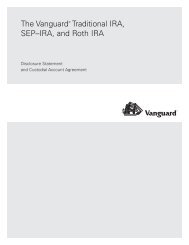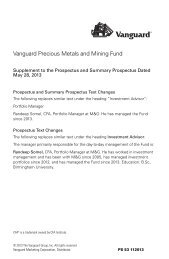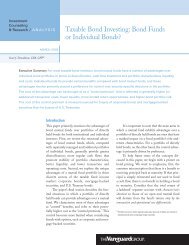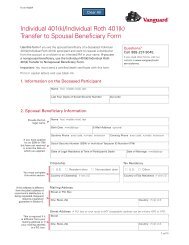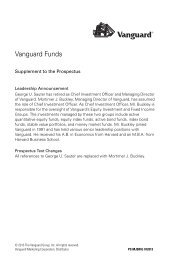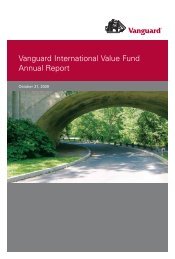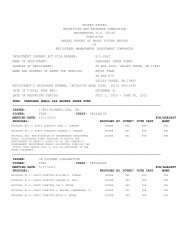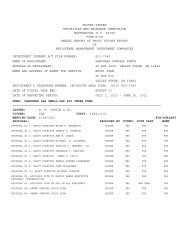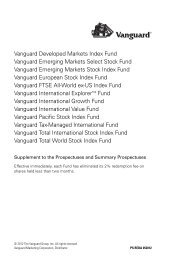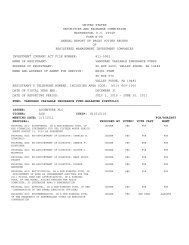Vanguard International Stock Index Funds Annual Report
Vanguard International Stock Index Funds Annual Report
Vanguard International Stock Index Funds Annual Report
You also want an ePaper? Increase the reach of your titles
YUMPU automatically turns print PDFs into web optimized ePapers that Google loves.
end of 2008, as the credit markets virtually<br />
shut down, risk-averse investors flocked to<br />
U.S. Treasury bonds. The effect was to<br />
widen the difference between the lower<br />
yields of Treasuries and the higher yields<br />
of corporate bonds to a margin not seen<br />
since the Great Depression.<br />
Central banks around the world responded<br />
to the economic slowdown by lowering<br />
interest rates and implementing other<br />
aggressive stimulus programs. Meanwhile,<br />
governments boosted spending in hopes<br />
of reversing the recessionary tide. As<br />
fears of a worldwide depression eased,<br />
investors’ appetite for risk returned to<br />
more normal levels. The receding<br />
pessimism raised demand for corporate<br />
1 Derived from data provided by Lipper Inc.<br />
2 Select Emerging Markets <strong>Index</strong> through August 23, 2006; MSCI Emerging Markets <strong>Index</strong> thereafter.<br />
bonds, pushing up their prices and<br />
bringing down their yields. Over the past<br />
12 months, both taxable and municipal<br />
bonds returned more than 13%.<br />
However, the Fed’s easy-money campaign<br />
had a predictable effect on short-term<br />
savings vehicles such as money market<br />
funds, whose yields track prevailing shortterm<br />
rates. In December 2008, the Fed<br />
reduced its target for the federal funds<br />
rate, a benchmark for the interest rates<br />
paid by money market instruments<br />
and other very short-term securities,<br />
to between 0% and 0.25%. The Fed has<br />
said it expects to maintain its target at<br />
this level “for an extended period.”<br />
Total Returns<br />
Ten Years Ended October 31, 2009<br />
Average<br />
<strong>Annual</strong> Return<br />
European <strong>Stock</strong> <strong>Index</strong> Fund Investor Shares 2.83%<br />
MSCI Europe <strong>Index</strong> 2.80<br />
European Region <strong>Funds</strong> Average 1 2.96<br />
Pacific <strong>Stock</strong> <strong>Index</strong> Fund Investor Shares 0.08%<br />
MSCI Pacific <strong>Index</strong> 0.42<br />
Japan/Pacific Region <strong>Funds</strong> Average 1 –2.46<br />
Emerging Markets <strong>Stock</strong> <strong>Index</strong> Fund Investor Shares 11.14%<br />
Spliced Emerging Markets <strong>Index</strong> 2 11.64<br />
Emerging Markets <strong>Funds</strong> Average1 10.64<br />
The figures shown represent past performance, which is not a guarantee of future results. (Current performance<br />
may be lower or higher than the performance data cited. For performance data current to the most recent monthend,<br />
visit our website at www.vanguard.com/performance.) Note, too, that both investment returns and principal<br />
value can fluctuate widely, so an investor’s shares, when sold, could be worth more or less than their original cost.<br />
7




